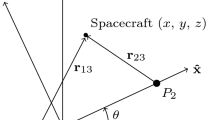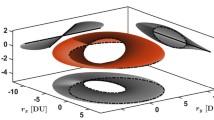Abstract
Fast Lyapunov Indicator (FLI) maps are presented as a tool for solving spacecraft preliminary trajectory design problems in multi-body environments with long-term stability requirements. In particular, the FLI maps are shown to provide a global overview of the dynamics in the restricted three-body problem that can guide mission designers in selecting long-term stable regions of phase space which are inherently more robust to model parameter perturbations. The FLI is also shown to numerically detect the normally hyperbolic manifolds associated with unstable periodic orbits. These, in turn, provide a global map of the principal heteroclinic connections between the various resonance regions which form the basic backbone of dynamical transfers design. Examples of maps and transfers are provided in the restricted three-body problem modeling the Jupiter–Europa system.
Similar content being viewed by others
References
Barrio, R., Borczyk, W., Breiter, S.: Spurious structure in chaos indicator maps. Chaos Solitons Fractals (2007). doi:10.1016/j.chaos.2007.09.084
Benettin G., Galgani L., Giorgilli A., Strelcyn J.M.: Lyapunov characteristic exponents for smooth dynamical systems and for Hamiltonian systems; a method for computing all of them, Part 1 & 2. Meccanica 15(1), 9–31 (1980)
Coffey S., Deprit A., Deprit E., Healy L.: Painting the phase space portrait of an integrable dynamical system. Science 247(4944), 833–836 (1990)
Contopoulos G., Voglis N.: A fast method for distinguishing between ordered and chaotic orbits. Astron. Astrophys. 317(1), 73–81 (1997)
Dellnitz M., Froyland G., Junge O.: The algorithms behind GAIO: set oriented numerical methods for dynamical systems. In: Fiedler, B. (eds) Ergodic Theory, Analysis, and Efficient Simulation of Dynamical Systems, pp. 145–174. Springer, Berlin (2001)
Dellnitz M., Junge O., Koon W.S., Lekien F., Lo M.W., Marsden J.E., Padberg K., Preis R., Ross S.D., Thiere B.: Transport in dynamical astronomy and multibody problems. Int. J. Bifurcat Chaos 15, 699–727 (2005)
Dunham, D.W., Jen, S.J., Roberts, C.E., Seacord, A.W., II, Sharer, P.J., Folta, D.C., Muhonen, D.P.: Transfer trajectory design for the SOHO libration-point mission. International Astronautical Congress, IAF Paper 92-0066 (1992)
Easton R., Meiss J., Carver S.: Exit times and transport for symplectic twist maps. Chaos 3(2), 153–165 (1993)
Farquhar R.W., Muhonen D.P., Richardson D.L.: Mission design for a Halo orbiter or Earth. J. Spacecr. Rockets 14(3), 170–177 (1977)
Folta, D., Beckman, M.: Libration orbit mission design: applications of numerical & dynamical methods. International Conference on Libration Point Orbits and Applications, Girona, Spain, 10–14 June 2002
Fouchard M., Lega E., Froeschlé C., Froeschlé C.: On the relationship between fast Lyapunov indicator and periodic orbits for continuous flows. Celest. Mech. Dyn. Astron. 83, 205–222 (2002)
Froeschlé C., Lega E.: On the structure of symplectic mappings. The fast Lyapunov indicator: a very sensitive tool. Celest. Mech. Dyn. Astron. 78(1–4), 167–195 (2000)
Froeschlé C., Lega E., Gonczi R.: Fast Lyapunov indicators. Application to asteroidal motion. Celest. Mech. Dyn. Astron. 67(1), 41–62 (1997)
Froeschlé C., Guzzo M., Lega E.: Graphical evolution of the Arnold web: from order to chaos. Science 289(5487), 2108–2110 (2000)
Froeschlé C., Lega E., Guzzo M.: Analysis of the chaotic behaviour of orbits diffusing along the Arnold web. Celest. Mech. Dyn. Astron. 95(1–4), 141–153 (2006)
Gómez G., Koon W.S., Lo M.W., Marsden J.E., Masdemont J., Ross S.D.: Connecting orbits and invariant manifolds in the spatial three-body problem. Nonlinearity 17, 1571–1606 (2004)
Gurfil P., Kasdin N.J.: Optimal out-of-ecliptic trajectories for space-borne observatories. J. Astronaut. Sci. 49(4), 509–537 (2001)
Guzzo M., Lega E., Froeschlé C.: On the numerical detection of the effective stability of chaotic motions in quasi-integrable systems. Physica D Nonlinear Phenom. 163(1–2), 1–25 (2002)
Hénon M.: Numerical exploration of the restricted problem. VI. Hill’s case: non-periodic orbits. Astron. Astrophys. 9, 24–36 (1970)
Howell K.C.: Families of orbits in the vicinity of the collinear libration points. J. Astronaut. Sci. 49(1), 107–125 (2001)
Howell, K., Grebow, D.: Design using Gauss perturbing equations with applications to lunar south pole coverage. AAS/AIAA Space Flight Mechanics Meeting, Sedona, Arizona, January 2007.
Johannesen, J., D’Amario, L.: Europa orbiter mission trajectory design. Paper AAS 99-360, AAS/AIAA, Astrodynamics Specialist Conference, Girdwood, Alaska, USA, August 1999
Jorba A.: A methodology for the numerical computation of normal forms, centre manifolds and first integrals of Hamiltonian systems. Exp. Math. 8(2), 155–195 (1999)
Koon W.S., Lo M.W., Marsden J.E., Ross S.D.: Heteroclinic connections between periodic orbits and resonance transition in celestial mechanics. Chaos 10(2), 427–469 (2000)
Lam, T., Whiffen, G.J.: Exploration of distant retrograde orbits around Europa. Paper AAS 05-110, presented at the 15th Spaceflight Mechanics meeting, Copper Mountain, Colorado, January 2005
Lara, M., Russell, R., Villac, B.: On parking solutions around Europa. Paper AAS 05-384, presented at the 2005 AAS/AIAA Astrodynamics specialists conference, Lake Tahoe, CA, 2005
Lara M., Russell R., Villac B.: Classification of the distant stability regions at Europa. J. Guide Control Dyn. 30(2), 409–418 (2007a)
Lara M., Russell R., Villac B.: Estimation of long term stability orbits in real systems. Meccanica Int. Theor. Appl. Mech. 42(5), 511–515 (2007b)
Lega E., Froeschlé C.: On the relationship between fast Lyapunov indicator and periodic orbits for symplectic mappings. Celest. Mech. Dyn. Astron. 81(1–2), 129–147 (2001)
Lega E., Guzzo M., Froeschlé C.: Detection of Arnold diffusion in Hamiltonian systems. Physica D Nonlinear Phenom. 182(3–4), 179–187 (2003)
Lo, M.W., Parker, J.S.: Unstable resonant orbits near earth and their applications in planetary missions. Paper AIAA 2004-5304, AIAA/AAS Astrodynamics Specialist Conference, Providence, RI, 16–19 August 2004
Lo, M.W., Williams, B.G., Bollman, W.E., Han, D., Hahn, Y., Bell, J.L., Hirst, E.A., Corwin, R.A., Hong, P.E., Howell, K.C.: Genesis mission design. Paper AIAA 1998-4468, AIAA/AAS Astrodynamics Specialist Conference and Exhibit, Boston, MA, 10–12 August 1998
Lo, M.W., Anderson, R.L., Lam, T., Whiffen, G.: The role of invariant manifolds in low thrust trajectory design (Part III). Paper AAS 06-190, AAS/AIAA Spaceflight Mechanics Conference, Tampa, Florida, January 22–26, 2006
Morbidelli, A.: Modern Celestial Mechanics. Aspects of Solar System Dynamics. Taylor & Francis/Cambridge Scientific Publishers (2002)
Morbidelli A., Giorgilli A.: Superexponential stability of KAM tori. J. Stat. Phys. 78(5–6), 1607–1617 (1995)
Oseledec V.I.: A multiplicative ergodic theorem. Lyapunov characteristic numbers for dynamical systems. Trans. Moscow Math. Soc. 19, 197–231 (1968)
Perry A.D., Wiggins S.: KAM tori are very sticky—rigorous lower bounds on the time to move. Physica D 71(1–2), 102–121 (1994)
Pesin Y.B.: Characteristic Lyapunov exponents and smooth ergodic theory. Russian Math. Surveys 32(4), 55–114 (1977)
Robutel P., Laskar J.: Frequency map and global dynamics in the solar system I. Icarus 152, 4–28 (2001)
Russell R.P.: Global search for planar and three-dimensional periodic orbits near Europa. J. Astronaut. Sci. 54(2), 199–226 (2006)
Simó C.: Global dynamics and fast indicators. In: Broer, H.W., Krauskopf, B., Vegter, G. (eds) Global Analysis of Dynamical Systems, IOP, Bristol (2001)
Skokos Ch., Antonopoulos Ch., Bountis T.C., Vrahatis M.N.: Detecting order and chaos in Hamiltonian systems by the SALI method. J. Phys. A Math. Gen. 37(24), 6269–6284 (2004)
Szebehely V.: Theory of Orbits, the Restricted Problem of Three Bodies. Academic Press, New York (1967)
Villac, B.: Impulsive transfer strategies along stable periodic orbit families. Paper AAS 08-249 AAS Spaceflight Mechanics Meeting, TX, January 2008
Villac, B., Aiello, J.: Mapping long-term stability regions using the fast Lyapunov indicator. Paper AAS 05-188, presented at the 15th AAS Spaceflight Mechanics Meeting, Copper Mountain, CO, 2005
Villac, B., Lara, M.: Stability maps, global dynamics and transfers. Paper AAS 05-378, presented at the 2005 AAS/AIAA Astrodynamics Specialists Conference, Lake Tahoe, CA, 2005
Villac, B.F., Scheeres, D.J.: A simple algorithm to compute hyperbolic invariant manifolds near L1 and L2. AAS/AIAA Spaceflight Mechanics Meeting, Maui, Hawai’i, Paper AAS 04-243, 2004
Voglis N., Contopoulos G., Efthymiopoulos C.: Detection of ordered and chaotic motion using the dynamical spectra. Celest. Mech. Dyn. Astron. 73(1–4), 211–220 (1999)
Whiffen, G.: A preliminary investigation of the Jupiter Icy Moon Orbiter. Paper AAS 03-354, presented at the 2003 AAS/AIAA Astrodynamics Specialists Conference, Big Sky, Montana, 2003
Zimmer, S., Ocampo, C., Bishop, R.: Decreasing semi-major axis uncertainty through trajectory design. Paper AAS05-333, AIAA/AAS Astrodynamics Specialists Conference, Lake Tahoe, CA, 2005
Author information
Authors and Affiliations
Corresponding author
Rights and permissions
About this article
Cite this article
Villac, B.F. Using FLI maps for preliminary spacecraft trajectory design in multi-body environments. Celest Mech Dyn Astr 102, 29–48 (2008). https://doi.org/10.1007/s10569-008-9158-1
Received:
Revised:
Accepted:
Published:
Issue Date:
DOI: https://doi.org/10.1007/s10569-008-9158-1




